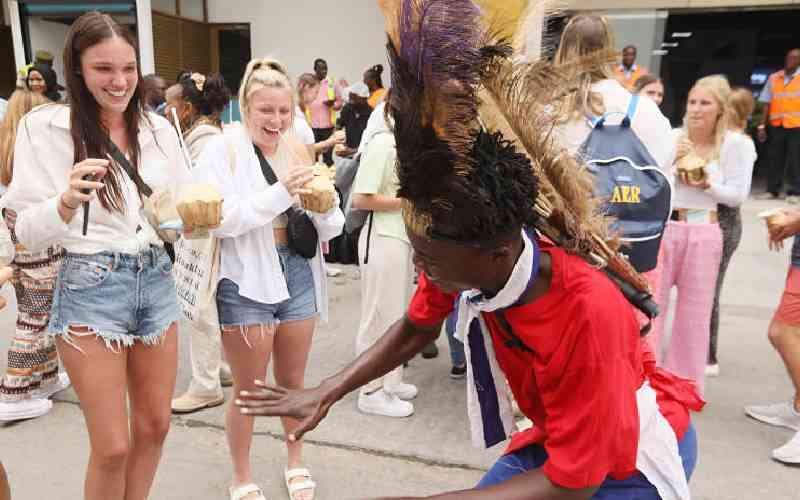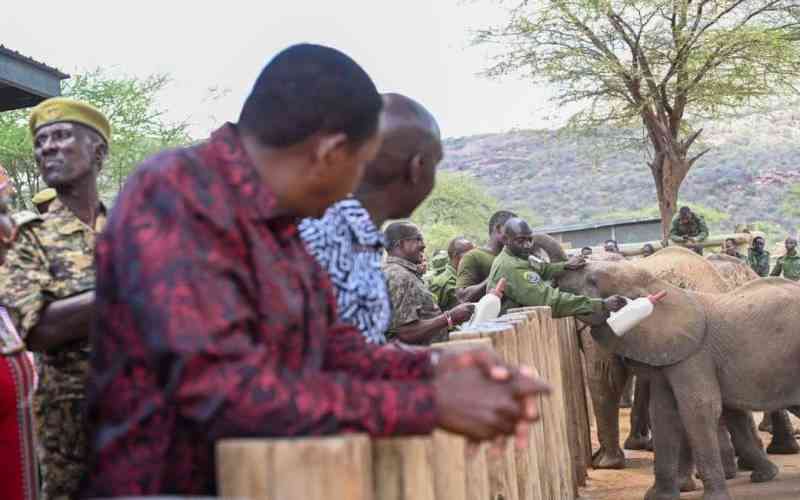 |
|
Bernard Lemashon bottle feeding a six months old Thompson gazelle in Namanga.The gazelle was rescued after the mother abandoned her.PHOTO.FIDELIS KABUNYI |
Nairobi; Kenya: It is impossible to ignore the welcome feel of Namanga.
There is a lot of construction going on both on the Kenyan and Tanzanian sides.
But besides the dust and the noise from the machines, the people are very warm — the same kind of warmth you feel when in the company of people you have known all your life.
We checked in at Namanga River Hotel in the evening.
On our way to the hotel, we made a stopover at a private boma; a large expanse of semi-arid land, with lots of goats, cows and camels.
It is my first time to see so many camels together. We arrive just in time for their second milking, and the Maasai herdsman shows us how its done.
Apparently, camels can be milked three times a day, and they produce more milk than an average dairy cow.
To milk them, you have to be quick and be able to balance on one foot for an extended period of time, as the milking bucket will be balanced by the other.
One camel is always milked by two people from either end.
The herders challenge us to drink the camel milk straight from the bucket.
We cringe at first, but still he gives each of us a cup of milk.
We sip and I do not know if we were expecting the milk to taste funny because we were surprised at how tasty it was.
Since crossing over to the Tanzanian side looked very easy and inviting, we decided to have our dinner across the border.
SUMPTUOUS FOOD
Of course the prejudice we have as Kenyans over the Tanzanians is that they are slow.
Stay informed. Subscribe to our newsletter
This was clearly at play when we asked to be served, but after waiting for an hour for our food, we warmed up to each other.
However, there were some stark differences and one thing we found very odd is the 330ml soda bottle unlike the 300 ml we have in Kenya.
However, the food was sumptuous. Namanga River Hotel has been in existence since pre-Independence days, we learn that the following day, during breakfast.
It was built in 1930 by an ex-British soldier who used it as a rest house during the photographic tours he organised in Kenya and Tanzania.
Everything is as it was when it was built. In the dining area, there is a skull of a buffalo which is as old as the hotel.
Our host tells us that the walls were built using mud, and finishing was done with cement.
It is hard to believe as everything is in tip-top condition.
The garden is well manicured, with climbers going up most of the buildings.
It still is a favourite stop over for travellers going to Tanzania, as we meet a group of bikers who checked in for the day.
The hotel is very close to Amboseli National Park.
On researching further, I discover that the person who started the Namanga River Hotel was very instrumental in having the park declared a national reserve back in 1948.
He was the first person to put in word to the trustees to make it a protected area. He used to take many visitors to Amboseli, and in 1934, he established a small camp known as Rhino Camp in Ol Tukai. At the gate of Amboseli, a group of women trying to sell some of the Maasai beaded jewellery, swarm around us.
The park is very dry. In fact, we drive on the now dry lake. Our guide tells us that this area is relatively salty, and its not clear if it is the reason there are no trees in Amboseli or it is because the elephants have uprooted them.
We see the elephants from afar walking in a swampy area. There is lots of bird life in this park, as well as bufallos, hippopotamus, gazelles, impalas and the white bearded wildebeest, which I learn do not migrate.
Namanga is cosmopolitan and it is not uncommon to see the Maasai dressed in their traditional attire, just like it is very easy to see a Kanzu-clad Somali here.
UNTOLD STORY OF KENYA
People are so friendly to each other nonetheless. The hotel staff are quite free with us, something we find heartwarming. A Kenyan of Somalia descent, fondly referred to as Cheupe because he is light-skinned, insists on showing us the bridge at the back of the hotel that was built by the Italian prisoners of war in 1943. It is still intact.
I learn that camel rearing was not originally part of the Maasai culture, but was introduced to them by non-state bodies out to stem the ‘poverty’ they face during the dry season.
Aside from camels, the Maasai have also adopted some gazelles, and are cross-breeding them with goats.
When we left Namanga, I felt like I found treasure, having bumped into pieces of information that form part of the untold story of Kenya.
 The Standard Group Plc is a
multi-media organization with investments in media platforms spanning newspaper
print operations, television, radio broadcasting, digital and online services. The
Standard Group is recognized as a leading multi-media house in Kenya with a key
influence in matters of national and international interest.
The Standard Group Plc is a
multi-media organization with investments in media platforms spanning newspaper
print operations, television, radio broadcasting, digital and online services. The
Standard Group is recognized as a leading multi-media house in Kenya with a key
influence in matters of national and international interest.
 The Standard Group Plc is a
multi-media organization with investments in media platforms spanning newspaper
print operations, television, radio broadcasting, digital and online services. The
Standard Group is recognized as a leading multi-media house in Kenya with a key
influence in matters of national and international interest.
The Standard Group Plc is a
multi-media organization with investments in media platforms spanning newspaper
print operations, television, radio broadcasting, digital and online services. The
Standard Group is recognized as a leading multi-media house in Kenya with a key
influence in matters of national and international interest.










